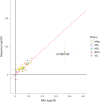Rare variants with large effects provide functional insights into the pathology of migraine subtypes, with and without aura
- PMID: 37884687
- PMCID: PMC10632135
- DOI: 10.1038/s41588-023-01538-0
Rare variants with large effects provide functional insights into the pathology of migraine subtypes, with and without aura
Abstract
Migraine is a complex neurovascular disease with a range of severity and symptoms, yet mostly studied as one phenotype in genome-wide association studies (GWAS). Here we combine large GWAS datasets from six European populations to study the main migraine subtypes, migraine with aura (MA) and migraine without aura (MO). We identified four new MA-associated variants (in PRRT2, PALMD, ABO and LRRK2) and classified 13 MO-associated variants. Rare variants with large effects highlight three genes. A rare frameshift variant in brain-expressed PRRT2 confers large risk of MA and epilepsy, but not MO. A burden test of rare loss-of-function variants in SCN11A, encoding a neuron-expressed sodium channel with a key role in pain sensation, shows strong protection against migraine. Finally, a rare variant with cis-regulatory effects on KCNK5 confers large protection against migraine and brain aneurysms. Our findings offer new insights with therapeutic potential into the complex biology of migraine and its subtypes.
© 2023. The Author(s).
Conflict of interest statement
Authors affiliated with deCODE Genetics/Amgen declare competing financial interests as employees. The remaining authors declare no competing financial interests.
Figures




References
MeSH terms
Grants and funding
- R01 DA006227/DA/NIDA NIH HHS/United States
- R01 MH101782/MH/NIMH NIH HHS/United States
- R01 MH101810/MH/NIMH NIH HHS/United States
- R01 MH101819/MH/NIMH NIH HHS/United States
- R01 MH090936/MH/NIMH NIH HHS/United States
- R01 MH090951/MH/NIMH NIH HHS/United States
- R01 MH101820/MH/NIMH NIH HHS/United States
- R01 MH101822/MH/NIMH NIH HHS/United States
- R01 MH101825/MH/NIMH NIH HHS/United States
- R01 MH090948/MH/NIMH NIH HHS/United States
- R01 MH090941/MH/NIMH NIH HHS/United States
- HHSN261200800001C/RC/CCR NIH HHS/United States
- R01 MH090937/MH/NIMH NIH HHS/United States
- HHSN268201000029C/HL/NHLBI NIH HHS/United States
- HHSN261200800001E/CA/NCI NIH HHS/United States
- R01 MH101814/MH/NIMH NIH HHS/United States
LinkOut - more resources
Full Text Sources
Medical
Miscellaneous

